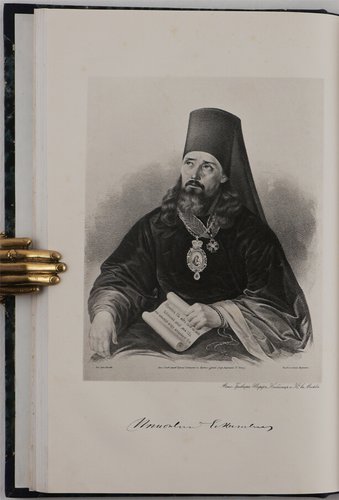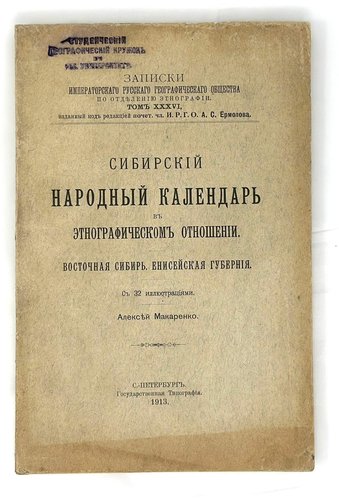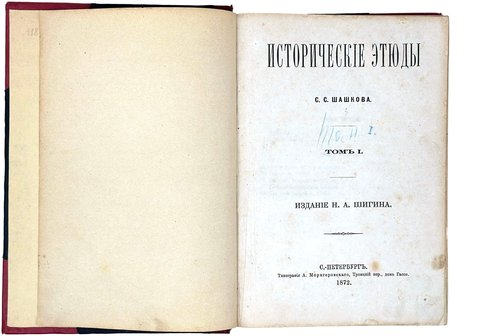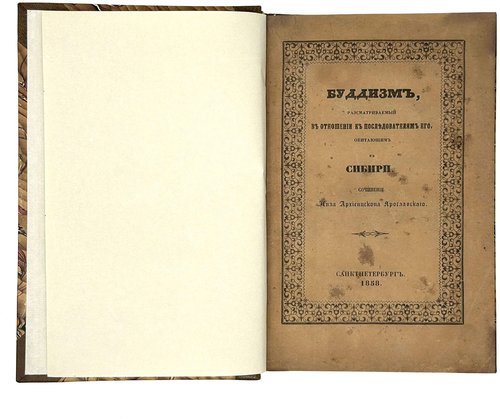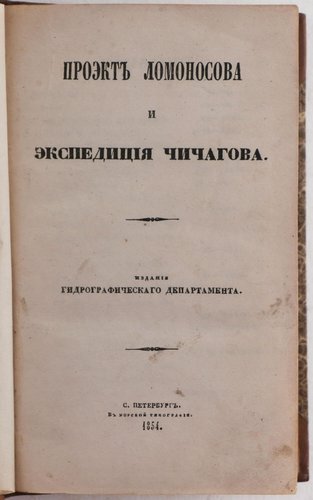

























#R97
1817
First and only edition. Large Octavo (ca. 23,5x14 cm). [2 – t.p.], [2 - copper-engraved dedication leaf to Emperor Alexander I], [3 – dedication to Emperor Alexander I], [5 – official correspondence regarding the publication], [6 - preface], [2 – table of contents], 230, 186 pp. With ten copper engraved plates, two large folding copper engraved maps of Lake Baikal and Eastern Siberia (the latter with borders outlined in colour), and a large folding table at rear. Our copy is bound without the copper-engraved half-title page, apparently also absent in some institutional copies. Handsome period style black half straight-grained morocco with marbled papered boards; spine with gilt-tooled decorations and a gilt-lettered title. Title and engraved dedication leaf with minor repairs on the inner margin, otherwise a very good copy.
Very Rare Russian imprint with only seven paper copies found in Worldcat (Library of Congress, University of Alaska Fairbanks, University of California Berkeley, Yale University, New York Public Library, British Library, State Library of Berlin). One of the earliest special Russian works on Irkutsk and Eastern Siberia written by Nikolay Semivsky after his three-year service as a vice-governor of the Irkutsk Province (1806-1809). The book also contains notes about the Russian American Company’s offices in Irkutsk and other Siberian cities and quotes from several Imperial decrees regarding RAC’s privileges and trade between Kamchatka and the Sandwich Islands.
The book was based on printed and manuscript sources and Semivsky’s observations during his life in Siberia. In 1806, he sailed up the Angara River to the Main Irkutsk Salt Factory near modern-day Usolye, about 70 km north of Irkutsk. His companions were a local official Vasily Lavrentyevich Potresov (a councillor of Irkutsk state “Ekspeditsia” dealing with fur trade with the natives) and Ivan Antonovich Losev, a local artist and Irkutsk civil architect. During the trip, Losev drew several views which were included in the book (i.e. plate III, showing the hills on the Angara banks, see p. 145 of the main narration); Losev also authored the plan of Irkutsk placed in the book. According to several Russian bibliographers and historians (V. Mezhov, M. Azadovskii), for the text, Semivsky used the notes and materials of Losev’s father, a noted Irkutsk geographer, cartographer and historian, Anton Ivanovich Losev (1765-1829).
The first pages contain the correspondence between three Russian statesmen (Sergey Vyazmitinov, Alexey Razumovsky, Dmitry Guryev) discussing the review of the book by a renowned Russian navigator and explorer Gavriil Sarychev (1763-1831) who praised it and noted that “the northeastern part of Siberia which he [Semivsky] had a chance to travel through was described in its true state, both regarding its geography and inhabitants” (see p. [7]). As a result, the book was published on the account of the Russian Emperor, whose privy purse donated 5000 roubles for the publication (p. [9]).
The book contains an extensive and well-written description of Irkutsk and its surroundings, Irkutsk Province including Yakutsk district, Chukotka and Kamchatka, Lake Baikal, Lena and Angara Rivers and their tributaries; details the region’s industry and trade et al. There is also a description of a route from Saint Petersburg to Irkutsk by land or rivers, with all stations on the way, and a table of distances between the cities of the Irkutsk province and between those and the Russian “capitals” (Saint Petersburg and Moscow). Separate chapters are dedicated to St. Innocent of Irkutsk (ca. 1680-1731) and the local Voznesensky monastery. The book also has 50 numbered “Comments or Curious Notes” supplementing the chapters on miscellaneous matters: the meaning of the word “Siberia” (No. 1), grave of the famous merchant and a founder of Russian America Grigory Shelekhov in the Irkutsk Znamensky Monastery (No. 4), earthquakes in Irkutsk (No. 8), navigation on Lake Baikal (No. 16), a description of Chukotka (No. 33), a dictionary of local Siberian words and expressions (No. 10, pp. 16-26), navigation and Russian settlers on the Amur River, Albazin, and Russian Orthodox Mission in Beijing (No. 38), Chamar Daban mountain range near Lake Baikal (No. 17), tea trade with China in Kyakhta and Buddhism (No. 47) et al. The narration is supplemented with several poems by Semivsky including an unsigned “Letter from Neva to Angara” – one of the first Russian poems about Lake Baikal (pp. 43-44), poems addressed to his travel companions Ivan Losev (p. 46, signed “N.S.”) and Vasily Potresov (p. 110, signed “S”), a poem addressed to Irkutsk orphans (pp. 3-6, signed “N-y S-y”) etc.
Although not specially dedicated to Russian America, the book includes several interesting notes about Alaska, Russian American Company and navigation in the Pacific, which were closely connected to Irkutsk and Kamchatka – the majority of the first members of the RAC were Irkutsk merchants, the first headquarters of the RAC was in Irkutsk, and up to the 1830s most of the supplies for the RAC’s ships were prepared on the Irkutsk wharves (sails, rigging, anchors etc.).
[The Newest Description of Irkutsk and Environs]: “… a stone building with wooden additions which belongs to the Russian American Company, there its Main Office is located, [which is used] both for sending people to the American colonies, different supplies and for sorting before transportation all furs and other goods received from North America;” “In two locations in Irkutsk two-storey stone barracks have been built on account of the Russian American Company <…>, which cost 70,000 roubles, including the donation of 10,000 roubles by the family of late Grigory Shelekhov…” (pp. 21-22).
[Statistical Overview of the Irkutsk Province in its Modern State]: “Privileges from now on for 20 years Gracefully granted to the Russian American Company, kept under the Highest Patronage, on the 8th of July 1799, and the Highest Charter granted to the Company on the 27th of December, same year, read: 1) Upon discovery from the distant times by Russian navigators of the coast of the Northeast [sic!] part of America, starting with 55° northern lattitude and groups of islands stretching from Kamchatka north to America and south to Japan, and accorging to the right of possession by Russia, We Gracefully permit the Company to use all riches and lands located now on the Northeast [sic!] coast of America, from the above mentioned 55° to the Bering Strait and beyond, also on the Islands Aleut, Kurile and others, laying on the Northeast Ocean; 2) To make new discoveries not only higher than 55° northern lattitude, but also further south and to stake the discovered lands into Russian possession according to the existing rules, if only these haven’t been staked and made dependent by other nations…” (pp. 161-162).
[about the new Imperial Provision on Kamchatka, issued on April 9, 1812]: “It has also been proposed, when the security of navigation is restored [a referral to the Napoleonic Wars], every two years to send from Kronstadt one transport vessel under protection of a naval frigate, to sail around Cape Horn or Cape of Good Hope to the Petropavlovsk harbour with all necessary supplies for Kamchatka, Izhiga and Okhotsk, with the condition that they call at the Sandwich Islands and take there salt for Kamchatka and Okhotsk. With this, all needs of our remote lands will cost, as is known by calculations and experience, ten times cheaper than now, with the transportation via Yakutsk to Okhotsk and thence by sea to Kamchatka; and meanwhile, naval officers going on these ships should endeavour to gain skills in the art of navigation of great seas. <…> Moreover, one naval vessel will be used for perfecting the naval charts of the remote regions, local places and even for the discoveries with auspicious circumstances of new islands. By the same Provision about the reorganization of Kamchatka, it was Highly ordered that the Chief Administrator of Kamchatka should send a naval vessel to the Kurile and Aleut Islands for the observation of the people under Russia’s governance and to report to the Government about the state of those people and of all other American settlements” (pp. 202-204).
[Offices and trade representatives of the Russian American Company in the Irkutsk Province]: four offices (Irkutsk, Kyakhta, Yakutsk and Okhotsk), and two trade representatives (Izhiginsk and Petropavlovsk) (p. 213).
[Notes or Curious Remarks]:
[Note 2. List of names of the bishops of the Irkutsk diocese]: “By the Highest Decree from July 19, 1796 there was formed the Diocese of Irkutsk for the North American Colonies, and the its first bishop was consecrated in Irkutsk in 1799; it was Archimandrite Ioasaf, who had previously been to North America; he was titled the Bishop of Kodiak and later when he left for Kodiak from Okhotsk on board the ship “Phoenix”, he drowned in the Eastern Ocean together with the ship” (p. 4 of the Notes).
[Note 33. Brief Description of the Chukotskaya Land]: “It’s not rare that in Summer by their baidars or large boats, and in Winter by ice on deer and dogs they [Chukchi] travel to the islands and through the Bering Strait to North America for trade with the Americans, and sometimes for robbery” (p. 78 of the Notes).
The book is illustrated with two perfectly executed maps of Eastern Siberia and Lake Baikal, and ten views of Irkutsk, Baikal, Angara and Lena. The map of Baikal, dated 1806 and supplemented with a decorative cartouche “A view of Nikolskaya pier at the point where Angara flows out of Baikal” (apparently portraying Semivsky and his travel companions), is one of the first detailed maps of the lake; the insert shows the Posolsky Bay on the lake’s eastern shore. The “Newest Map of Eastern Siberia Compiled in 1816” shows the area from the Siberian Arctic shore down to Mongolia and Manchuria in the south, from the Ob River and Kara Sea in the west to Bering Strait in the east, with parts of Alaska, St. Lawrence Islands and Commodore Islands (marked as Aleutian Islands); borders between different Siberian provinces and districts outlined in colour; Sakhalin is shown as a peninsula and a part of China, the Kuriles are shown as Russian possession as far south as the Urup Island (marked as “Alexander Island” – the name given by the Russian American Company’s officers), Iturup Island is shown as a part of Japan; Russian-Chinese border is marked along the Argun River and the Stanovoy Range according to the Treaty of Nerchinsk (1689); north of the Kotelny Island in the Arctic Ocean there are two copper engraved referrals to the “Land seen by Sannikov” (a phantom island which had been searched for almost a century but was never found).
The plates include a plan of Irkutsk, three views of Irkutsk (panorama from the north, Voznesensky monastery, a wharf with merchant ships), views of Lake Baikal, Angara and Lena Rivers, a monogram of St. Innocent, a vignette with “an allegorical picture of the Irkutsk Province,” and a map of confluence of Yenisey and Angara.
The book was included in several Russian catalogues of illustrated and rare books: Obolianinov (SPb, 1914, # 1814); Shibanov (Catalogue 149, M., 1909, # 585); Solovyov (No. 123; # 439, “Rare”); Mezhdunarodnaya Kniga (Catalogue 76, M., 1936, # 514); A.E. Bourtsev noted that “Clean copies in good condition are very rare” (Obstoyatelnoye bibliograficheskoye opisaniye redkikh i zamechatelnykh knig. SPb, 1914, vol. III, # 1071).


























